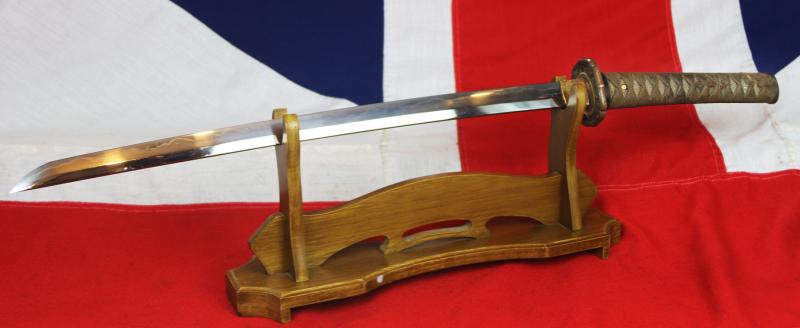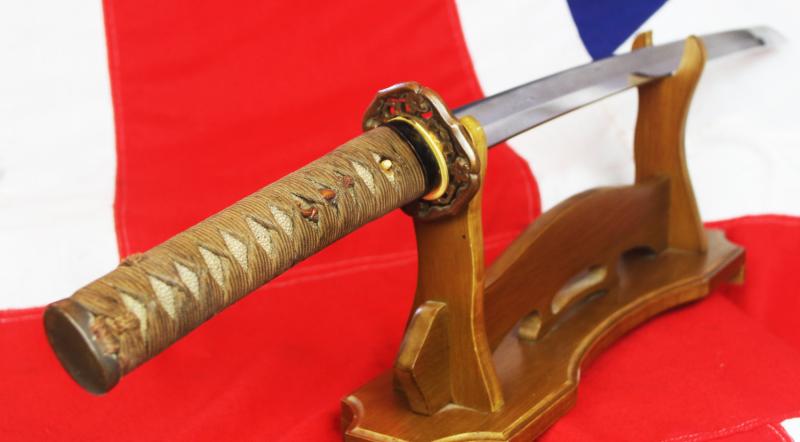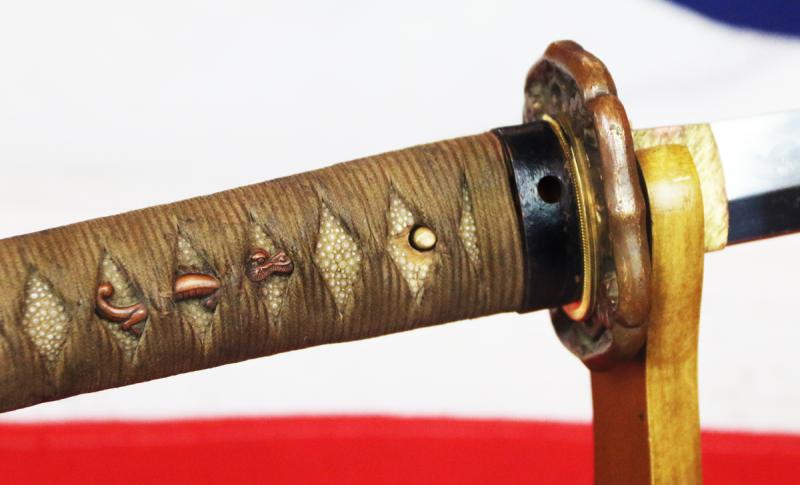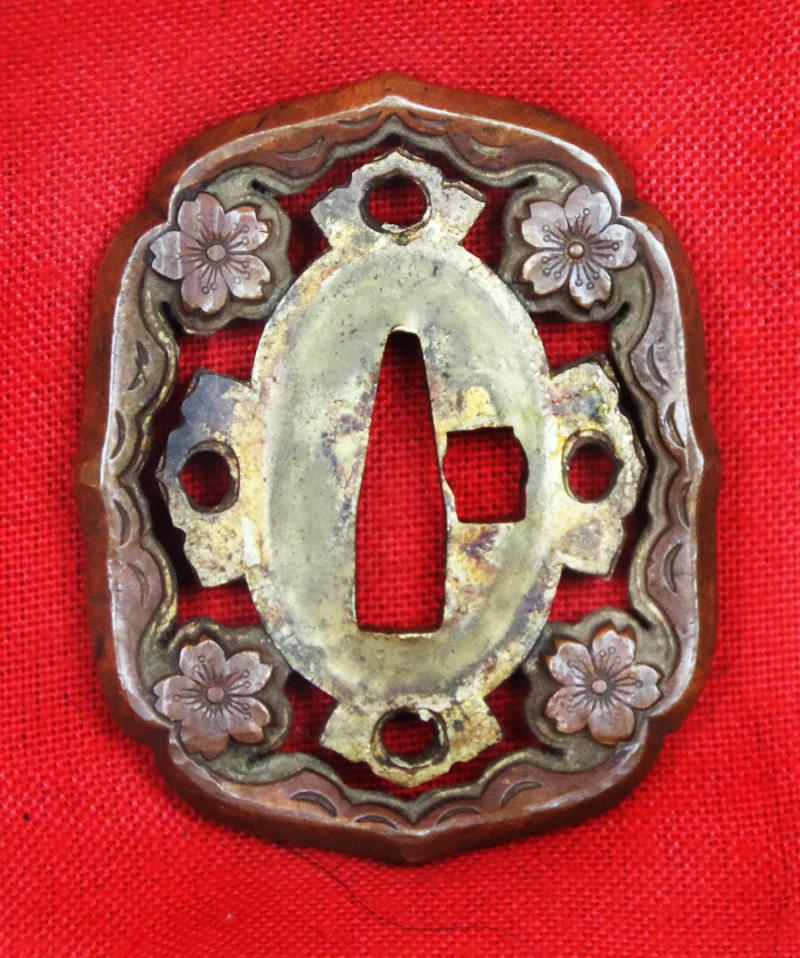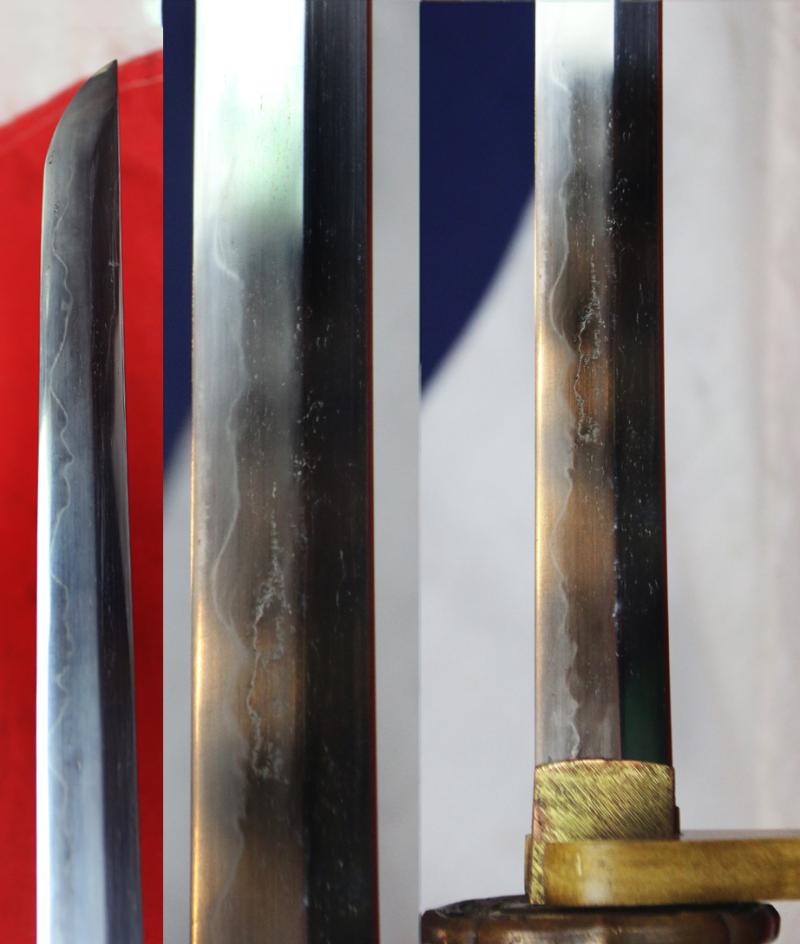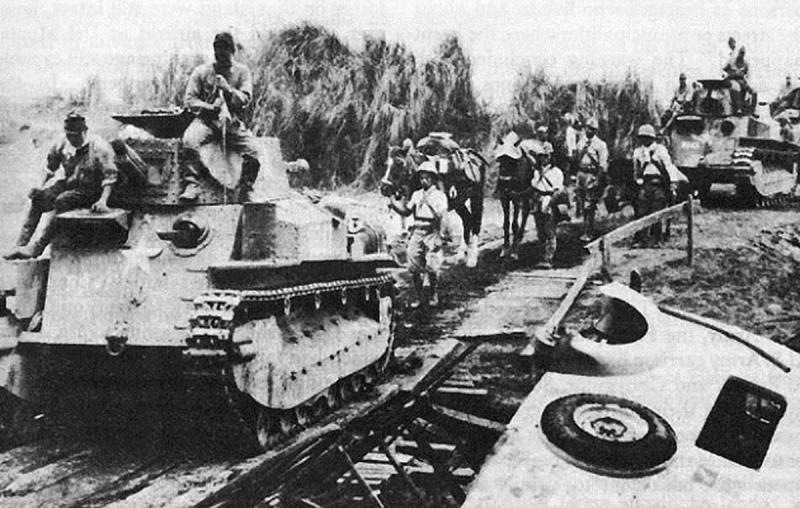A Super Antique Ancestral Japanese Sword. Koto Blade, Around 500 Years Old. A WW2 Officers Katana, Antique, Edo Period, Traditional Tsuka {Hilt}. Unusual Short Size, For Tank Officer Service
With original wood and lacquer Edo period traditional samurai sword saya {scabbard}. Wrapped in its WW2 issue camouflage combat leather field service cover, and a traditional military single ring belt mount. Early, and rare, top quality type 94 pierced military tsuba. The blade is in beautiful polish still showing a fulsome and elaborate midare hamon that is most stunning, and it also shows a super grain in the hada. The nakago is mumei, with numerous mekugi-ana. It has a good cat scratch gilt copper habaki {blade collar} with engraved 'rain pattern' that is named neko-gaki. The size of this katana was ideal for officer's serving in the IJA tank service, bearing in mind the size of their small tank's turret and interior. Somewhat short for traditional urban or jungle combat katana that would be used by a regular infantry IJA officer.
The original antique Edo tsuka has original silk wrap over the pair of stylized dragon menuki {hilt mounts} in copper, laid upon the traditional giant rayskin {samegawa}. Plain, patinated, antique copper fuchigashira, and the fuchi has a circular press-button aperture for an optional military button catch, as a way to lock the blade into the saya. The regulation saya retaining press button in the fuchi was often removed by the Japanese officer, and in fact was very often the case. On this sword the button was removed. The button clip was designed to hold the blade within its saya {scabbard} while ‘on the run” so to speak. This was a technical safety advantage, however, officers trained in iaido {the traditional martial art of the drawing of the sword from its saya} had no such fitting on regular katana, and if it was the button could cause a millisecond or even more of delay in combat, which by traditional swordplay standards is not only unacceptable it was also, potentially, a fatal drawback and disadvantage to the swordsman. Thus, they often removed and discarded this feature from the sword entirely.
World War Two
The tank force was primarily under the command of the IJA, and not the navy. Also, due to the nature of the Pacific theater, were operations mostly involved small islands ill-suited for tanks, these were deployed only in several large scale operational areas, were they could be effective in blitzkrieg-style tactics. These include China, the Philippines, Burma, Indonesia (Java), while some were dispersed in support of infantry units on Okinawa, Iwo Jima and several other islands. On December 22, near Damortis, on Luzon island (Philippines) the first clash between Japanese and US tanks occurred. They were opposed to M3 and M2A4 light tanks of the American 192nd Tank Battalion. The 57 mm (2.24 in) gun of the Chi-Ha, then the best frontline IJA tank, proved useless against their armour. In Burma, engaging second and third rate light tanks, and a few Stuarts from the 2nd Royal Tank Regiment, the Japanese proved deadly. By 1943, the SNLF, or Navy Armored Force, received its first amphibious tanks, like the Ka-Mi. 223 units would be built until 1945.
The blade is most beautiful, with natural age surface wear and thinning in areas, but no combat damage at all, without any edge chips or cuts present. The chape area of the leather has separated and a very small area of leather cover lacking.
See photo 10 that shows a tank commander, sitting on his tank and leaning on what appears to be his sword.
Overall length in saya 36.5 inches, blade tsuba to tip 20.75 inches
The Hamon is the pattern we see on the edge of the blade of any Nihonto (日本刀) and it is not merely aesthetic, but is due to the differential tempering with clay applied to weapons in the forging process. Japanese katanas are unique in the way of the forging process, where apart from the materials the system is tremendously laborious. In short, before temper, the steel has different clays applied that when submerged in water causing the characteristic blade curvature and the pattern of the hamon. This also causes the katanas to be flexible and can be very sharp, since the hardening of the steels at different temperatures causes a part of the sword to be softer and more flexible called Mune or loin and the other harder and brittle, thus having a High quality cutting edge capable of making precise and lethal cuts.
There are various types and variants, some simple and others very complex. Depending on how the clay is applied, it can form numerous forms and types of hamon.
According to legend, Amakuni Yasutsuna developed the process of differential hardening of the blades around the 8th century. The emperor was returning from battle with his soldiers when Yasutsuna noticed that half of the swords were broken:
Amakuni and his son, Amakura, picked up the broken blades and examined them. They were determined to create a sword that will not break in combat and they were locked up in seclusion for 30 days. When they reappeared, they took the curved blade with them. The following spring there was another war. Again the soldiers returned, only this time all the swords were intact and the emperor smiled at Amakuni.
Although it is impossible to determine who invented the technique, surviving blades from Yasutsuna around AD 749–811 suggest that, at the very least, Yasutsuna helped establish the tradition of differentially hardening blades.
Blade tip to kashira 30 inches or 76 cm long {out of saya}
Code: 25426


